Comparing MRI and Ultrasound for Fetal Brain Imaging: A Review
VerifiedAdded on 2022/11/14
|12
|3656
|287
Report
AI Summary
This report provides a comparative analysis of Magnetic Resonance Imaging (MRI) and ultrasound techniques used in fetal neuroimaging. The paper begins with an abstract outlining the importance of antenatal imaging for detecting fetal brain anomalies and guiding patient counseling. It then discusses the scanning methods and safety considerations of both MRI and ultrasound, highlighting the advantages and disadvantages of each modality. Ultrasound is presented as the primary imaging method, with MRI being used for additional information when necessary. The report examines the different MRI sequences, including T1 and T2 weighted sequences, and compares them with ultrasound techniques. It also delves into the physics and application of both 2D and 3D ultrasound. The discussion includes the safety aspects of both methods, such as the effects of electromagnetic fields and acoustic noise in MRI, and thermal and mechanical effects in ultrasound. Overall, the report emphasizes the importance of correct image analysis and interpretation for providing helpful guidance to parents.
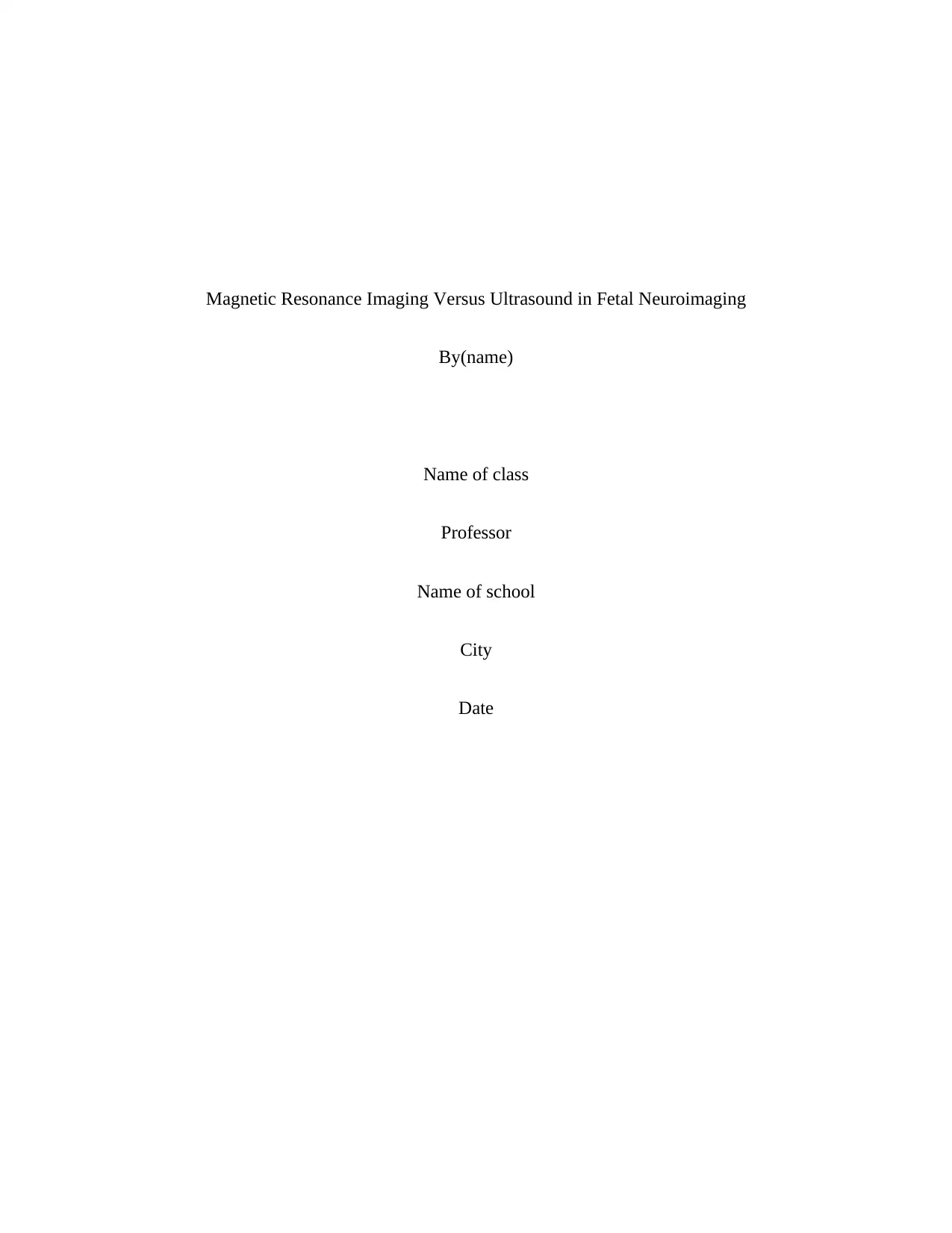
Magnetic Resonance Imaging Versus Ultrasound in Fetal Neuroimaging
By(name)
Name of class
Professor
Name of school
City
Date
By(name)
Name of class
Professor
Name of school
City
Date
Paraphrase This Document
Need a fresh take? Get an instant paraphrase of this document with our AI Paraphraser
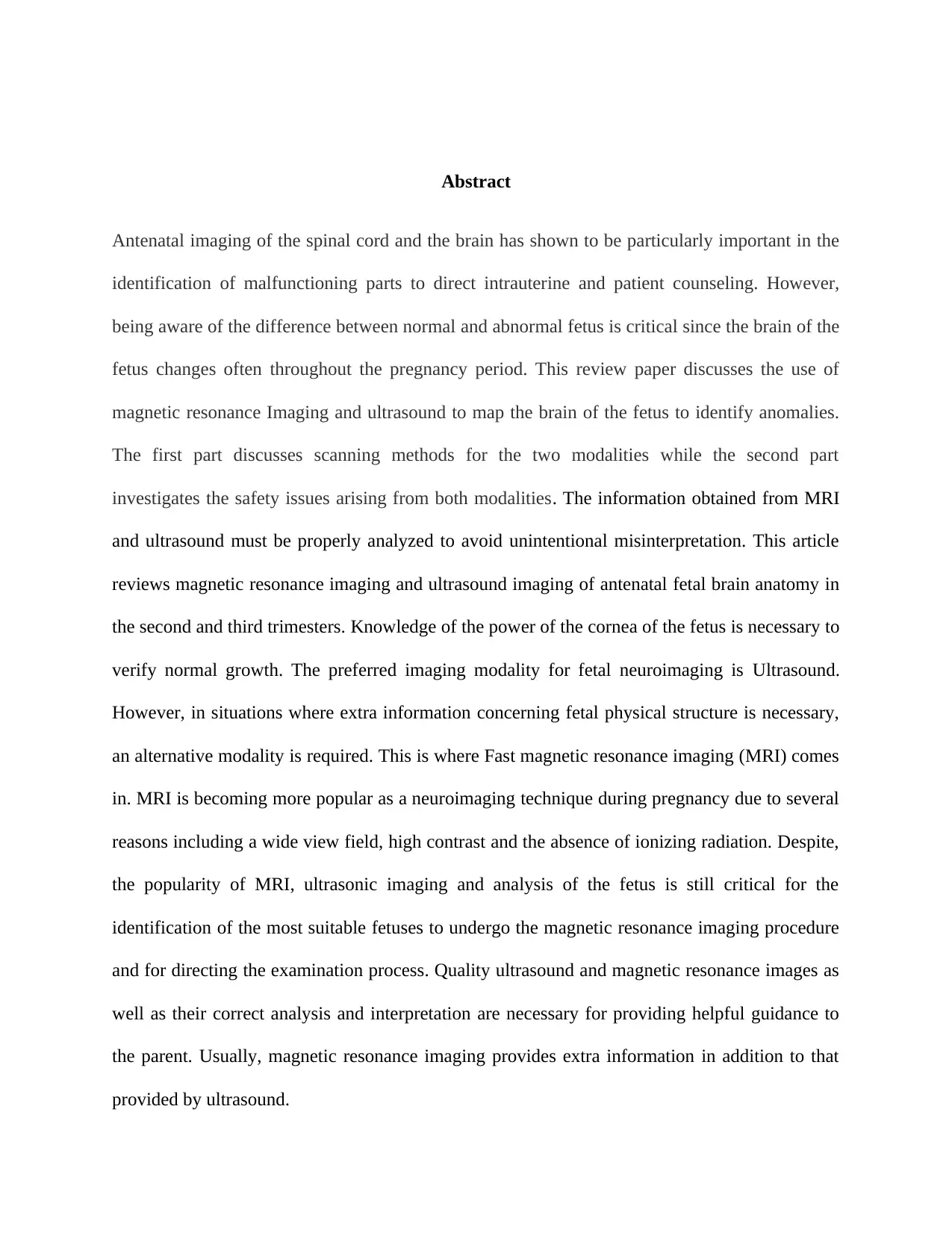
Abstract
Antenatal imaging of the spinal cord and the brain has shown to be particularly important in the
identification of malfunctioning parts to direct intrauterine and patient counseling. However,
being aware of the difference between normal and abnormal fetus is critical since the brain of the
fetus changes often throughout the pregnancy period. This review paper discusses the use of
magnetic resonance Imaging and ultrasound to map the brain of the fetus to identify anomalies.
The first part discusses scanning methods for the two modalities while the second part
investigates the safety issues arising from both modalities. The information obtained from MRI
and ultrasound must be properly analyzed to avoid unintentional misinterpretation. This article
reviews magnetic resonance imaging and ultrasound imaging of antenatal fetal brain anatomy in
the second and third trimesters. Knowledge of the power of the cornea of the fetus is necessary to
verify normal growth. The preferred imaging modality for fetal neuroimaging is Ultrasound.
However, in situations where extra information concerning fetal physical structure is necessary,
an alternative modality is required. This is where Fast magnetic resonance imaging (MRI) comes
in. MRI is becoming more popular as a neuroimaging technique during pregnancy due to several
reasons including a wide view field, high contrast and the absence of ionizing radiation. Despite,
the popularity of MRI, ultrasonic imaging and analysis of the fetus is still critical for the
identification of the most suitable fetuses to undergo the magnetic resonance imaging procedure
and for directing the examination process. Quality ultrasound and magnetic resonance images as
well as their correct analysis and interpretation are necessary for providing helpful guidance to
the parent. Usually, magnetic resonance imaging provides extra information in addition to that
provided by ultrasound.
Antenatal imaging of the spinal cord and the brain has shown to be particularly important in the
identification of malfunctioning parts to direct intrauterine and patient counseling. However,
being aware of the difference between normal and abnormal fetus is critical since the brain of the
fetus changes often throughout the pregnancy period. This review paper discusses the use of
magnetic resonance Imaging and ultrasound to map the brain of the fetus to identify anomalies.
The first part discusses scanning methods for the two modalities while the second part
investigates the safety issues arising from both modalities. The information obtained from MRI
and ultrasound must be properly analyzed to avoid unintentional misinterpretation. This article
reviews magnetic resonance imaging and ultrasound imaging of antenatal fetal brain anatomy in
the second and third trimesters. Knowledge of the power of the cornea of the fetus is necessary to
verify normal growth. The preferred imaging modality for fetal neuroimaging is Ultrasound.
However, in situations where extra information concerning fetal physical structure is necessary,
an alternative modality is required. This is where Fast magnetic resonance imaging (MRI) comes
in. MRI is becoming more popular as a neuroimaging technique during pregnancy due to several
reasons including a wide view field, high contrast and the absence of ionizing radiation. Despite,
the popularity of MRI, ultrasonic imaging and analysis of the fetus is still critical for the
identification of the most suitable fetuses to undergo the magnetic resonance imaging procedure
and for directing the examination process. Quality ultrasound and magnetic resonance images as
well as their correct analysis and interpretation are necessary for providing helpful guidance to
the parent. Usually, magnetic resonance imaging provides extra information in addition to that
provided by ultrasound.
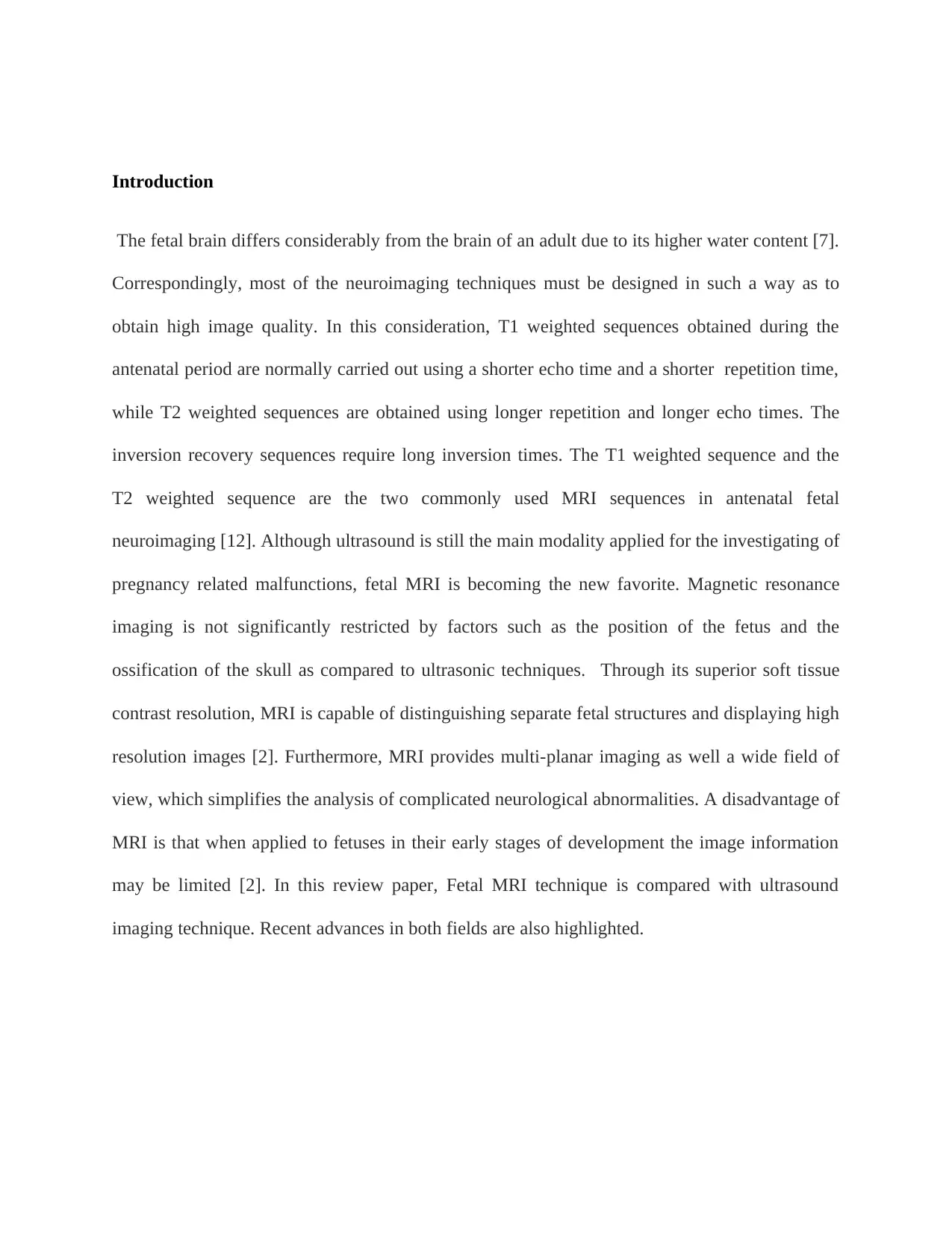
Introduction
The fetal brain differs considerably from the brain of an adult due to its higher water content [7].
Correspondingly, most of the neuroimaging techniques must be designed in such a way as to
obtain high image quality. In this consideration, T1 weighted sequences obtained during the
antenatal period are normally carried out using a shorter echo time and a shorter repetition time,
while T2 weighted sequences are obtained using longer repetition and longer echo times. The
inversion recovery sequences require long inversion times. The T1 weighted sequence and the
T2 weighted sequence are the two commonly used MRI sequences in antenatal fetal
neuroimaging [12]. Although ultrasound is still the main modality applied for the investigating of
pregnancy related malfunctions, fetal MRI is becoming the new favorite. Magnetic resonance
imaging is not significantly restricted by factors such as the position of the fetus and the
ossification of the skull as compared to ultrasonic techniques. Through its superior soft tissue
contrast resolution, MRI is capable of distinguishing separate fetal structures and displaying high
resolution images [2]. Furthermore, MRI provides multi-planar imaging as well a wide field of
view, which simplifies the analysis of complicated neurological abnormalities. A disadvantage of
MRI is that when applied to fetuses in their early stages of development the image information
may be limited [2]. In this review paper, Fetal MRI technique is compared with ultrasound
imaging technique. Recent advances in both fields are also highlighted.
The fetal brain differs considerably from the brain of an adult due to its higher water content [7].
Correspondingly, most of the neuroimaging techniques must be designed in such a way as to
obtain high image quality. In this consideration, T1 weighted sequences obtained during the
antenatal period are normally carried out using a shorter echo time and a shorter repetition time,
while T2 weighted sequences are obtained using longer repetition and longer echo times. The
inversion recovery sequences require long inversion times. The T1 weighted sequence and the
T2 weighted sequence are the two commonly used MRI sequences in antenatal fetal
neuroimaging [12]. Although ultrasound is still the main modality applied for the investigating of
pregnancy related malfunctions, fetal MRI is becoming the new favorite. Magnetic resonance
imaging is not significantly restricted by factors such as the position of the fetus and the
ossification of the skull as compared to ultrasonic techniques. Through its superior soft tissue
contrast resolution, MRI is capable of distinguishing separate fetal structures and displaying high
resolution images [2]. Furthermore, MRI provides multi-planar imaging as well a wide field of
view, which simplifies the analysis of complicated neurological abnormalities. A disadvantage of
MRI is that when applied to fetuses in their early stages of development the image information
may be limited [2]. In this review paper, Fetal MRI technique is compared with ultrasound
imaging technique. Recent advances in both fields are also highlighted.
⊘ This is a preview!⊘
Do you want full access?
Subscribe today to unlock all pages.

Trusted by 1+ million students worldwide

Ultrasound
The application of ultrasound in the field of medicine began in the early twentieth century.
Initially, it was applied in the field of therapy rather than in clinical diagnosis. The history of
ultrasound goes back to the18th century when it was applied to measure distance and to detect
objects under water. From then it was gradually advanced and incorporated in the field of
medicine. Sonar is an abbreviation for ‘sound navigation and ranging’. An ultrasound imaging
machine is a type of medical sonar which utilizes sonar’s thermal and disruptive effects on the
tissues of living things. The first neurologist credited with using ultrasound in the field of
medicine is Karl Theo Dussik, from Austria, Vienna.
All sound waves with a frequency greater than the human hearing threshold of approximately
18000 Hz are defined as being ultrasonic. Most ultrasonic Image scanners operate within a
frequency band of about 2 to 15 MHz. Choosing the frequency of operation is a matter of
compromise between image quality and the depth of penetration of the waves. Short wavelength
ultrasonic waves which correspondingly have high frequency produce high resolution images.
However, short wavelength waves have a higher level of attenuation per unit distance hence they
are only useful for superficial imaging. On the contrary, low frequency waves have a
correspondingly large wavelength hence they can penetrate deeper into the body due to the lower
level of attenuation. However, the images produced are of a lower resolution.
The source of the ultrasonic sound wave is usually a piezoelectric transducer enclosed in a probe.
The majority of piezoelectric transducers are constructed from ceramic materials. Part of the
incident pressure wave is returned back towards the source at a different angle (angle of
reflection) by tissue layers of different thickness. The reflected pressure wave causes the
The application of ultrasound in the field of medicine began in the early twentieth century.
Initially, it was applied in the field of therapy rather than in clinical diagnosis. The history of
ultrasound goes back to the18th century when it was applied to measure distance and to detect
objects under water. From then it was gradually advanced and incorporated in the field of
medicine. Sonar is an abbreviation for ‘sound navigation and ranging’. An ultrasound imaging
machine is a type of medical sonar which utilizes sonar’s thermal and disruptive effects on the
tissues of living things. The first neurologist credited with using ultrasound in the field of
medicine is Karl Theo Dussik, from Austria, Vienna.
All sound waves with a frequency greater than the human hearing threshold of approximately
18000 Hz are defined as being ultrasonic. Most ultrasonic Image scanners operate within a
frequency band of about 2 to 15 MHz. Choosing the frequency of operation is a matter of
compromise between image quality and the depth of penetration of the waves. Short wavelength
ultrasonic waves which correspondingly have high frequency produce high resolution images.
However, short wavelength waves have a higher level of attenuation per unit distance hence they
are only useful for superficial imaging. On the contrary, low frequency waves have a
correspondingly large wavelength hence they can penetrate deeper into the body due to the lower
level of attenuation. However, the images produced are of a lower resolution.
The source of the ultrasonic sound wave is usually a piezoelectric transducer enclosed in a probe.
The majority of piezoelectric transducers are constructed from ceramic materials. Part of the
incident pressure wave is returned back towards the source at a different angle (angle of
reflection) by tissue layers of different thickness. The reflected pressure wave causes the
Paraphrase This Document
Need a fresh take? Get an instant paraphrase of this document with our AI Paraphraser
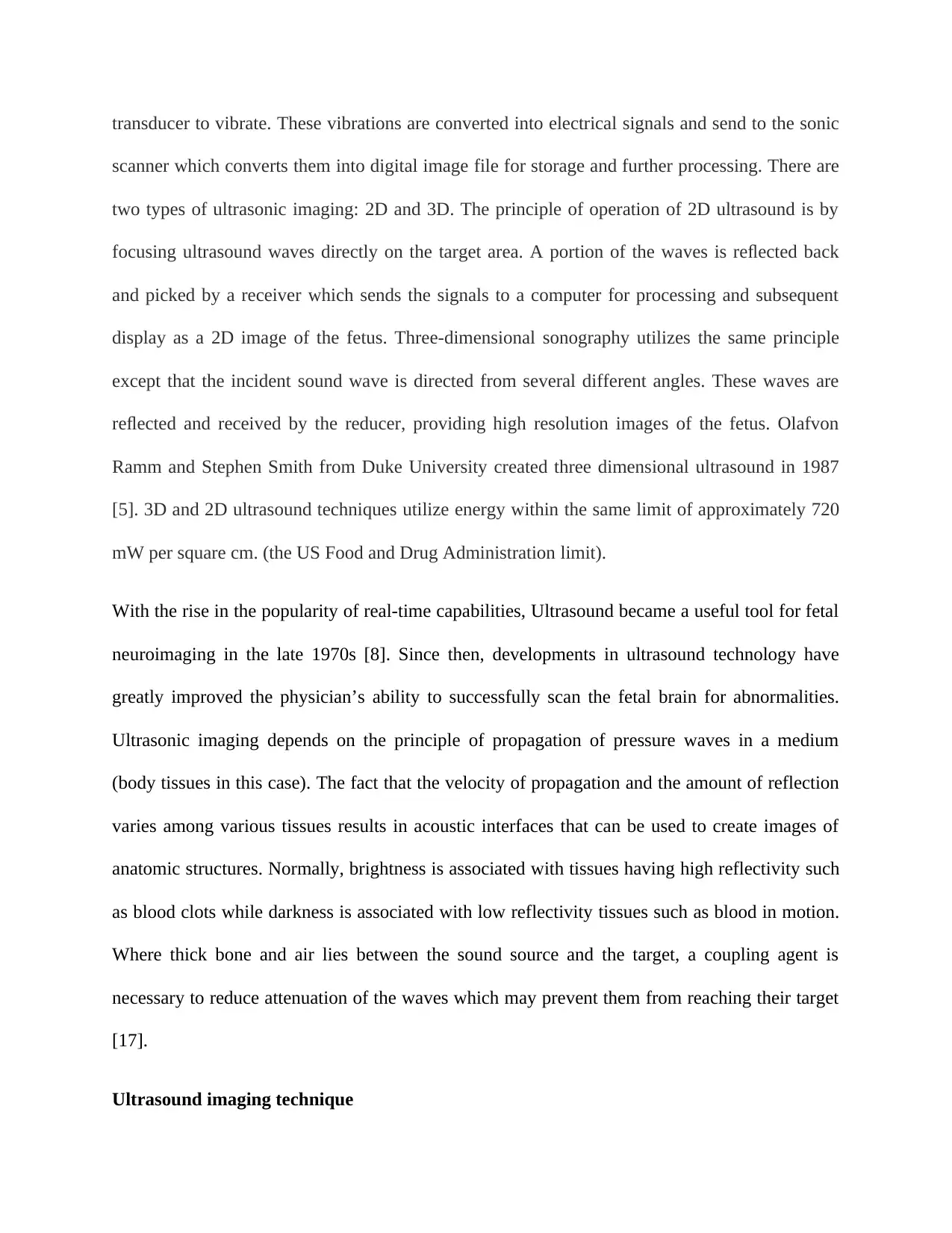
transducer to vibrate. These vibrations are converted into electrical signals and send to the sonic
scanner which converts them into digital image file for storage and further processing. There are
two types of ultrasonic imaging: 2D and 3D. The principle of operation of 2D ultrasound is by
focusing ultrasound waves directly on the target area. A portion of the waves is reflected back
and picked by a receiver which sends the signals to a computer for processing and subsequent
display as a 2D image of the fetus. Three-dimensional sonography utilizes the same principle
except that the incident sound wave is directed from several different angles. These waves are
reflected and received by the reducer, providing high resolution images of the fetus. Olafvon
Ramm and Stephen Smith from Duke University created three dimensional ultrasound in 1987
[5]. 3D and 2D ultrasound techniques utilize energy within the same limit of approximately 720
mW per square cm. (the US Food and Drug Administration limit).
With the rise in the popularity of real-time capabilities, Ultrasound became a useful tool for fetal
neuroimaging in the late 1970s [8]. Since then, developments in ultrasound technology have
greatly improved the physician’s ability to successfully scan the fetal brain for abnormalities.
Ultrasonic imaging depends on the principle of propagation of pressure waves in a medium
(body tissues in this case). The fact that the velocity of propagation and the amount of reflection
varies among various tissues results in acoustic interfaces that can be used to create images of
anatomic structures. Normally, brightness is associated with tissues having high reflectivity such
as blood clots while darkness is associated with low reflectivity tissues such as blood in motion.
Where thick bone and air lies between the sound source and the target, a coupling agent is
necessary to reduce attenuation of the waves which may prevent them from reaching their target
[17].
Ultrasound imaging technique
scanner which converts them into digital image file for storage and further processing. There are
two types of ultrasonic imaging: 2D and 3D. The principle of operation of 2D ultrasound is by
focusing ultrasound waves directly on the target area. A portion of the waves is reflected back
and picked by a receiver which sends the signals to a computer for processing and subsequent
display as a 2D image of the fetus. Three-dimensional sonography utilizes the same principle
except that the incident sound wave is directed from several different angles. These waves are
reflected and received by the reducer, providing high resolution images of the fetus. Olafvon
Ramm and Stephen Smith from Duke University created three dimensional ultrasound in 1987
[5]. 3D and 2D ultrasound techniques utilize energy within the same limit of approximately 720
mW per square cm. (the US Food and Drug Administration limit).
With the rise in the popularity of real-time capabilities, Ultrasound became a useful tool for fetal
neuroimaging in the late 1970s [8]. Since then, developments in ultrasound technology have
greatly improved the physician’s ability to successfully scan the fetal brain for abnormalities.
Ultrasonic imaging depends on the principle of propagation of pressure waves in a medium
(body tissues in this case). The fact that the velocity of propagation and the amount of reflection
varies among various tissues results in acoustic interfaces that can be used to create images of
anatomic structures. Normally, brightness is associated with tissues having high reflectivity such
as blood clots while darkness is associated with low reflectivity tissues such as blood in motion.
Where thick bone and air lies between the sound source and the target, a coupling agent is
necessary to reduce attenuation of the waves which may prevent them from reaching their target
[17].
Ultrasound imaging technique

In fetal neuroimaging during the early stages, a frequency range of about 7 to 10 MHz is
recommended for the transducers because the high frequency is enough for high resolution
images [20]. Transducers with lower frequency range of about 3.5 to 5 MHz are used for
adequate penetration into the growing brain. For imaging via the posterior and anterior fontanels,
wide field sector transducers are used.
Magnetic Resonance Imaging (MRI)
Magnetic resonance imaging utilizes time dependent electromagnetic fields, time invariant
magnetic fields and radiofrequency waves in pulsed form. MRI This clinical diagnostic
procedure has been in use since the late 1970s. No form of ionizing radiation is used in this
technique. Electromagnetic waves that are far much stronger than the earth’s magnetic field are
sent through the body. The magnetic field strength in the MRI system is given in terms of the SI
unit tesla. 1 tesla is equivalent to 10 000 gauss [11]. Currently, the magnets used in MRI have a
field strength in the range of approximately 0.5 to 3.0 T, or equivalently 5000 to 30 000 G. in
comparison, the magnetic field field strength of the earth is only 0.00005 T.
The magnetic field is so powerful that re-configures the structure of the atoms in its path, shifting
the nuclei into a different relative position. Once the excitation by the radiofrequency is
withdrawn the protons are free to regain their original configuration in the field after losing the
energy they had absorbed during excitation. This energy activates a coil and is detected as a
signal. The signal is then transmitted to the MRI scanner which then converts it into a digital file
containing the desired image. The strength and the location of the incoming signal determines
the characteristics of the image. Due to its considerably strong signal and the fact it is found in
abundance within the body, hydrogen is frequently used in MRI machines as the nucleus. The
recommended for the transducers because the high frequency is enough for high resolution
images [20]. Transducers with lower frequency range of about 3.5 to 5 MHz are used for
adequate penetration into the growing brain. For imaging via the posterior and anterior fontanels,
wide field sector transducers are used.
Magnetic Resonance Imaging (MRI)
Magnetic resonance imaging utilizes time dependent electromagnetic fields, time invariant
magnetic fields and radiofrequency waves in pulsed form. MRI This clinical diagnostic
procedure has been in use since the late 1970s. No form of ionizing radiation is used in this
technique. Electromagnetic waves that are far much stronger than the earth’s magnetic field are
sent through the body. The magnetic field strength in the MRI system is given in terms of the SI
unit tesla. 1 tesla is equivalent to 10 000 gauss [11]. Currently, the magnets used in MRI have a
field strength in the range of approximately 0.5 to 3.0 T, or equivalently 5000 to 30 000 G. in
comparison, the magnetic field field strength of the earth is only 0.00005 T.
The magnetic field is so powerful that re-configures the structure of the atoms in its path, shifting
the nuclei into a different relative position. Once the excitation by the radiofrequency is
withdrawn the protons are free to regain their original configuration in the field after losing the
energy they had absorbed during excitation. This energy activates a coil and is detected as a
signal. The signal is then transmitted to the MRI scanner which then converts it into a digital file
containing the desired image. The strength and the location of the incoming signal determines
the characteristics of the image. Due to its considerably strong signal and the fact it is found in
abundance within the body, hydrogen is frequently used in MRI machines as the nucleus. The
⊘ This is a preview!⊘
Do you want full access?
Subscribe today to unlock all pages.

Trusted by 1+ million students worldwide
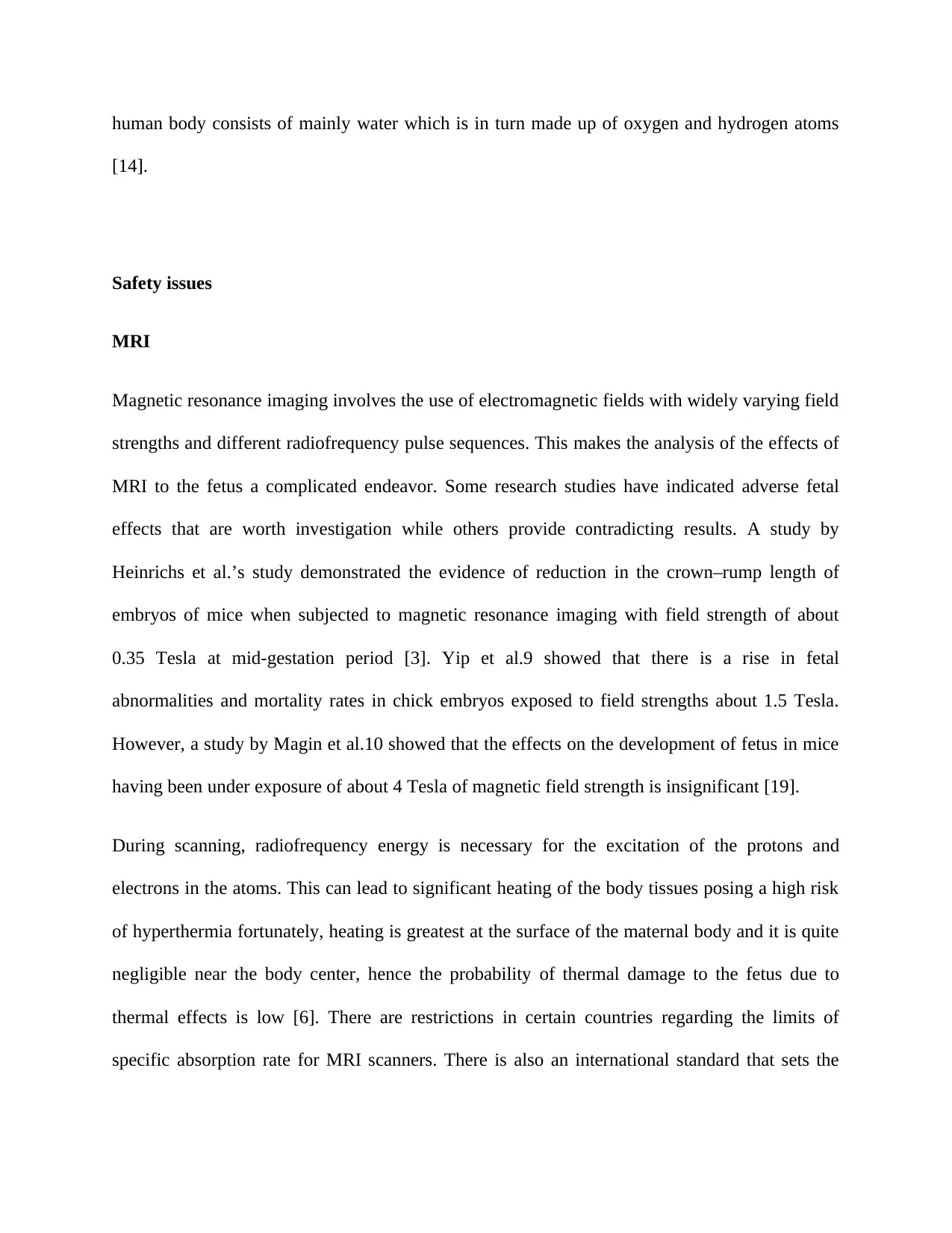
human body consists of mainly water which is in turn made up of oxygen and hydrogen atoms
[14].
Safety issues
MRI
Magnetic resonance imaging involves the use of electromagnetic fields with widely varying field
strengths and different radiofrequency pulse sequences. This makes the analysis of the effects of
MRI to the fetus a complicated endeavor. Some research studies have indicated adverse fetal
effects that are worth investigation while others provide contradicting results. A study by
Heinrichs et al.’s study demonstrated the evidence of reduction in the crown–rump length of
embryos of mice when subjected to magnetic resonance imaging with field strength of about
0.35 Tesla at mid-gestation period [3]. Yip et al.9 showed that there is a rise in fetal
abnormalities and mortality rates in chick embryos exposed to field strengths about 1.5 Tesla.
However, a study by Magin et al.10 showed that the effects on the development of fetus in mice
having been under exposure of about 4 Tesla of magnetic field strength is insignificant [19].
During scanning, radiofrequency energy is necessary for the excitation of the protons and
electrons in the atoms. This can lead to significant heating of the body tissues posing a high risk
of hyperthermia fortunately, heating is greatest at the surface of the maternal body and it is quite
negligible near the body center, hence the probability of thermal damage to the fetus due to
thermal effects is low [6]. There are restrictions in certain countries regarding the limits of
specific absorption rate for MRI scanners. There is also an international standard that sets the
[14].
Safety issues
MRI
Magnetic resonance imaging involves the use of electromagnetic fields with widely varying field
strengths and different radiofrequency pulse sequences. This makes the analysis of the effects of
MRI to the fetus a complicated endeavor. Some research studies have indicated adverse fetal
effects that are worth investigation while others provide contradicting results. A study by
Heinrichs et al.’s study demonstrated the evidence of reduction in the crown–rump length of
embryos of mice when subjected to magnetic resonance imaging with field strength of about
0.35 Tesla at mid-gestation period [3]. Yip et al.9 showed that there is a rise in fetal
abnormalities and mortality rates in chick embryos exposed to field strengths about 1.5 Tesla.
However, a study by Magin et al.10 showed that the effects on the development of fetus in mice
having been under exposure of about 4 Tesla of magnetic field strength is insignificant [19].
During scanning, radiofrequency energy is necessary for the excitation of the protons and
electrons in the atoms. This can lead to significant heating of the body tissues posing a high risk
of hyperthermia fortunately, heating is greatest at the surface of the maternal body and it is quite
negligible near the body center, hence the probability of thermal damage to the fetus due to
thermal effects is low [6]. There are restrictions in certain countries regarding the limits of
specific absorption rate for MRI scanners. There is also an international standard that sets the
Paraphrase This Document
Need a fresh take? Get an instant paraphrase of this document with our AI Paraphraser
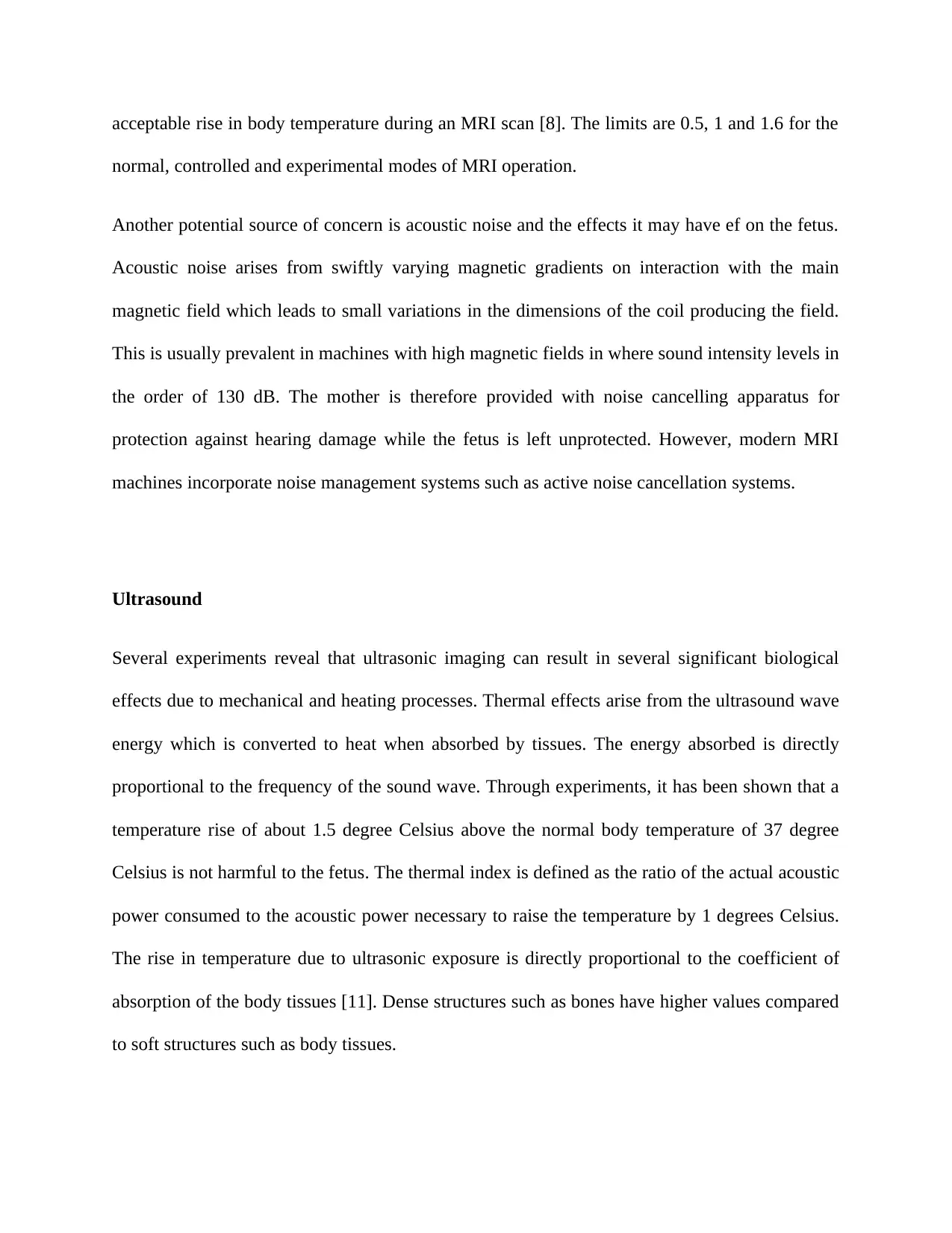
acceptable rise in body temperature during an MRI scan [8]. The limits are 0.5, 1 and 1.6 for the
normal, controlled and experimental modes of MRI operation.
Another potential source of concern is acoustic noise and the effects it may have ef on the fetus.
Acoustic noise arises from swiftly varying magnetic gradients on interaction with the main
magnetic field which leads to small variations in the dimensions of the coil producing the field.
This is usually prevalent in machines with high magnetic fields in where sound intensity levels in
the order of 130 dB. The mother is therefore provided with noise cancelling apparatus for
protection against hearing damage while the fetus is left unprotected. However, modern MRI
machines incorporate noise management systems such as active noise cancellation systems.
Ultrasound
Several experiments reveal that ultrasonic imaging can result in several significant biological
effects due to mechanical and heating processes. Thermal effects arise from the ultrasound wave
energy which is converted to heat when absorbed by tissues. The energy absorbed is directly
proportional to the frequency of the sound wave. Through experiments, it has been shown that a
temperature rise of about 1.5 degree Celsius above the normal body temperature of 37 degree
Celsius is not harmful to the fetus. The thermal index is defined as the ratio of the actual acoustic
power consumed to the acoustic power necessary to raise the temperature by 1 degrees Celsius.
The rise in temperature due to ultrasonic exposure is directly proportional to the coefficient of
absorption of the body tissues [11]. Dense structures such as bones have higher values compared
to soft structures such as body tissues.
normal, controlled and experimental modes of MRI operation.
Another potential source of concern is acoustic noise and the effects it may have ef on the fetus.
Acoustic noise arises from swiftly varying magnetic gradients on interaction with the main
magnetic field which leads to small variations in the dimensions of the coil producing the field.
This is usually prevalent in machines with high magnetic fields in where sound intensity levels in
the order of 130 dB. The mother is therefore provided with noise cancelling apparatus for
protection against hearing damage while the fetus is left unprotected. However, modern MRI
machines incorporate noise management systems such as active noise cancellation systems.
Ultrasound
Several experiments reveal that ultrasonic imaging can result in several significant biological
effects due to mechanical and heating processes. Thermal effects arise from the ultrasound wave
energy which is converted to heat when absorbed by tissues. The energy absorbed is directly
proportional to the frequency of the sound wave. Through experiments, it has been shown that a
temperature rise of about 1.5 degree Celsius above the normal body temperature of 37 degree
Celsius is not harmful to the fetus. The thermal index is defined as the ratio of the actual acoustic
power consumed to the acoustic power necessary to raise the temperature by 1 degrees Celsius.
The rise in temperature due to ultrasonic exposure is directly proportional to the coefficient of
absorption of the body tissues [11]. Dense structures such as bones have higher values compared
to soft structures such as body tissues.
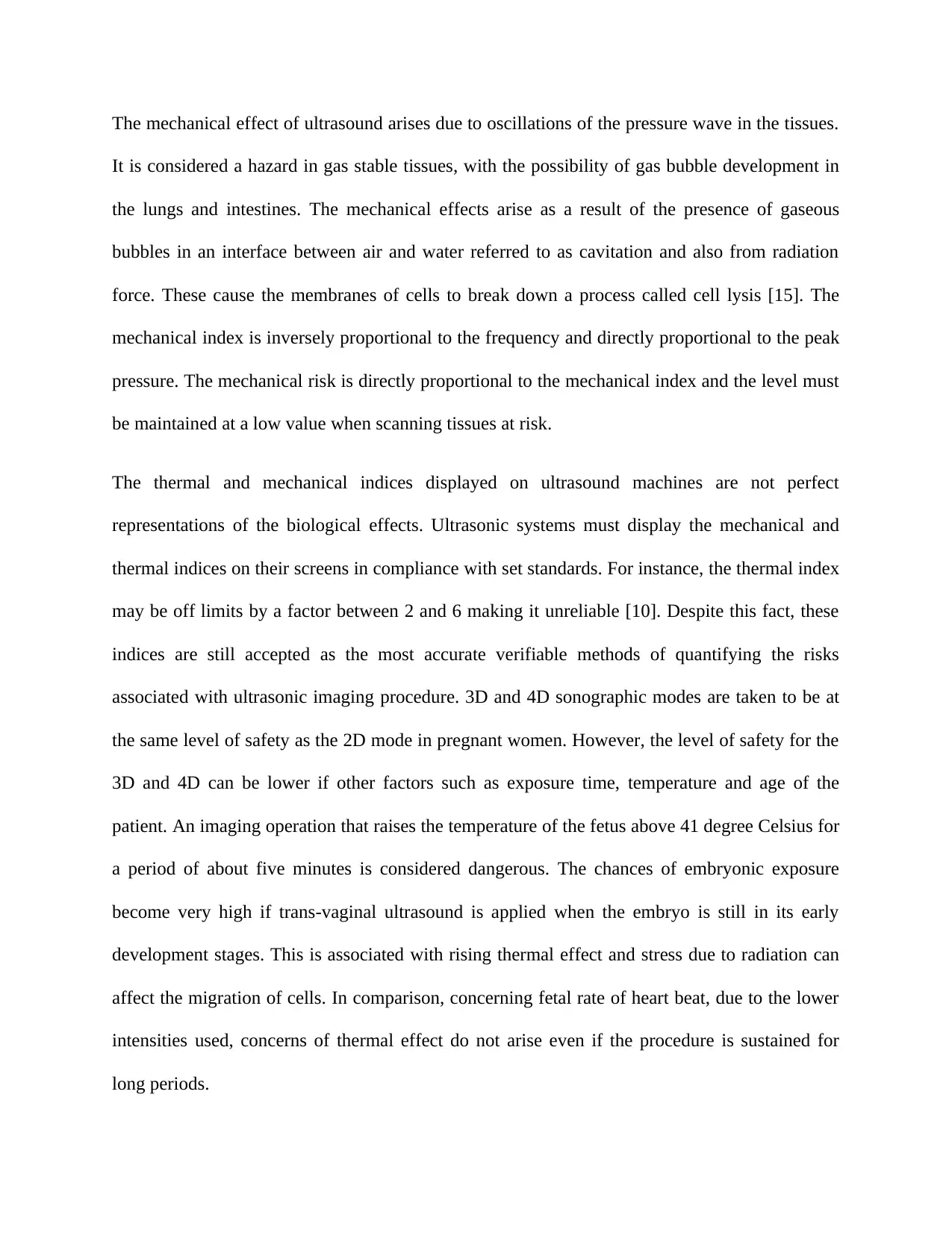
The mechanical effect of ultrasound arises due to oscillations of the pressure wave in the tissues.
It is considered a hazard in gas stable tissues, with the possibility of gas bubble development in
the lungs and intestines. The mechanical effects arise as a result of the presence of gaseous
bubbles in an interface between air and water referred to as cavitation and also from radiation
force. These cause the membranes of cells to break down a process called cell lysis [15]. The
mechanical index is inversely proportional to the frequency and directly proportional to the peak
pressure. The mechanical risk is directly proportional to the mechanical index and the level must
be maintained at a low value when scanning tissues at risk.
The thermal and mechanical indices displayed on ultrasound machines are not perfect
representations of the biological effects. Ultrasonic systems must display the mechanical and
thermal indices on their screens in compliance with set standards. For instance, the thermal index
may be off limits by a factor between 2 and 6 making it unreliable [10]. Despite this fact, these
indices are still accepted as the most accurate verifiable methods of quantifying the risks
associated with ultrasonic imaging procedure. 3D and 4D sonographic modes are taken to be at
the same level of safety as the 2D mode in pregnant women. However, the level of safety for the
3D and 4D can be lower if other factors such as exposure time, temperature and age of the
patient. An imaging operation that raises the temperature of the fetus above 41 degree Celsius for
a period of about five minutes is considered dangerous. The chances of embryonic exposure
become very high if trans-vaginal ultrasound is applied when the embryo is still in its early
development stages. This is associated with rising thermal effect and stress due to radiation can
affect the migration of cells. In comparison, concerning fetal rate of heart beat, due to the lower
intensities used, concerns of thermal effect do not arise even if the procedure is sustained for
long periods.
It is considered a hazard in gas stable tissues, with the possibility of gas bubble development in
the lungs and intestines. The mechanical effects arise as a result of the presence of gaseous
bubbles in an interface between air and water referred to as cavitation and also from radiation
force. These cause the membranes of cells to break down a process called cell lysis [15]. The
mechanical index is inversely proportional to the frequency and directly proportional to the peak
pressure. The mechanical risk is directly proportional to the mechanical index and the level must
be maintained at a low value when scanning tissues at risk.
The thermal and mechanical indices displayed on ultrasound machines are not perfect
representations of the biological effects. Ultrasonic systems must display the mechanical and
thermal indices on their screens in compliance with set standards. For instance, the thermal index
may be off limits by a factor between 2 and 6 making it unreliable [10]. Despite this fact, these
indices are still accepted as the most accurate verifiable methods of quantifying the risks
associated with ultrasonic imaging procedure. 3D and 4D sonographic modes are taken to be at
the same level of safety as the 2D mode in pregnant women. However, the level of safety for the
3D and 4D can be lower if other factors such as exposure time, temperature and age of the
patient. An imaging operation that raises the temperature of the fetus above 41 degree Celsius for
a period of about five minutes is considered dangerous. The chances of embryonic exposure
become very high if trans-vaginal ultrasound is applied when the embryo is still in its early
development stages. This is associated with rising thermal effect and stress due to radiation can
affect the migration of cells. In comparison, concerning fetal rate of heart beat, due to the lower
intensities used, concerns of thermal effect do not arise even if the procedure is sustained for
long periods.
⊘ This is a preview!⊘
Do you want full access?
Subscribe today to unlock all pages.

Trusted by 1+ million students worldwide
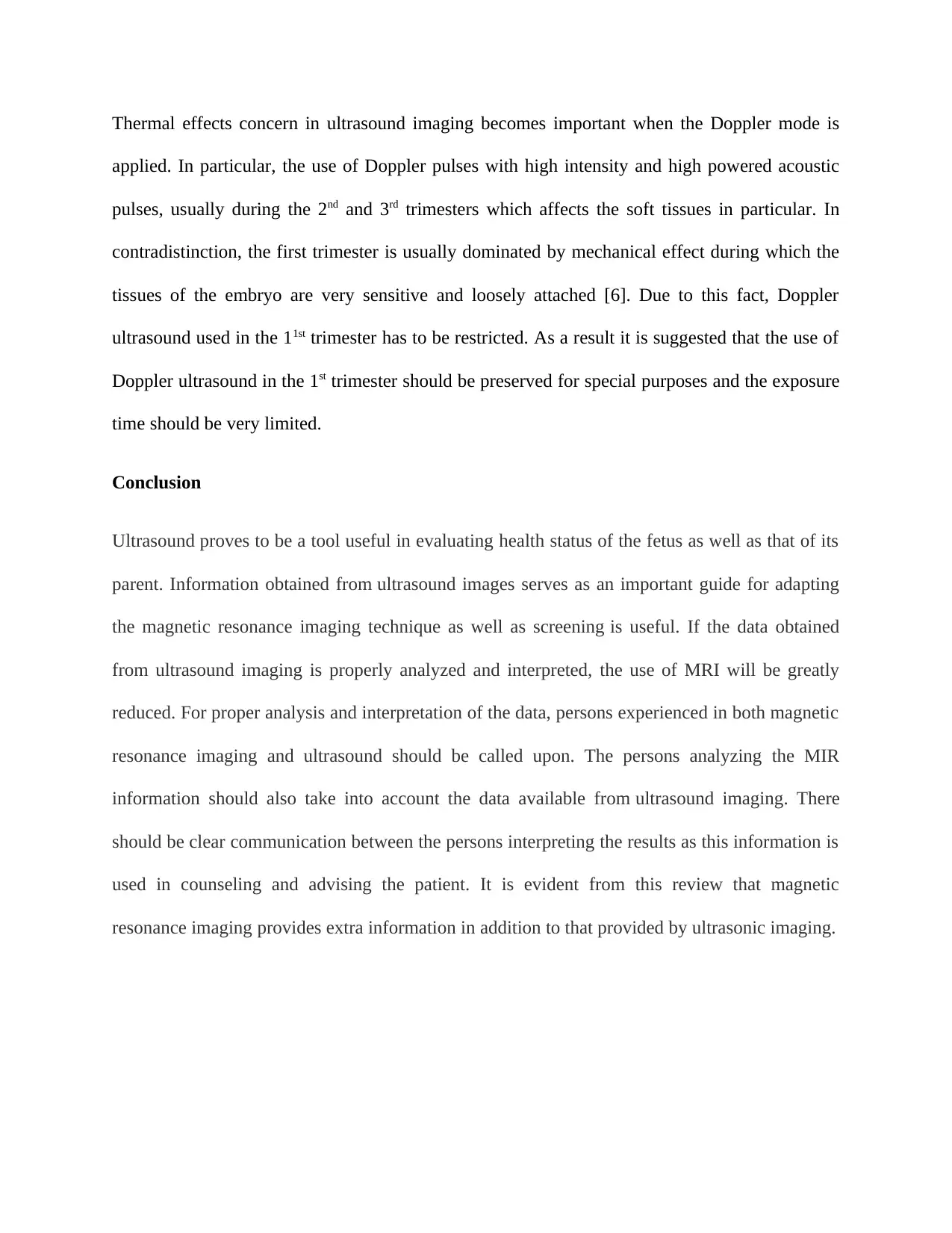
Thermal effects concern in ultrasound imaging becomes important when the Doppler mode is
applied. In particular, the use of Doppler pulses with high intensity and high powered acoustic
pulses, usually during the 2nd and 3rd trimesters which affects the soft tissues in particular. In
contradistinction, the first trimester is usually dominated by mechanical effect during which the
tissues of the embryo are very sensitive and loosely attached [6]. Due to this fact, Doppler
ultrasound used in the 11st trimester has to be restricted. As a result it is suggested that the use of
Doppler ultrasound in the 1st trimester should be preserved for special purposes and the exposure
time should be very limited.
Conclusion
Ultrasound proves to be a tool useful in evaluating health status of the fetus as well as that of its
parent. Information obtained from ultrasound images serves as an important guide for adapting
the magnetic resonance imaging technique as well as screening is useful. If the data obtained
from ultrasound imaging is properly analyzed and interpreted, the use of MRI will be greatly
reduced. For proper analysis and interpretation of the data, persons experienced in both magnetic
resonance imaging and ultrasound should be called upon. The persons analyzing the MIR
information should also take into account the data available from ultrasound imaging. There
should be clear communication between the persons interpreting the results as this information is
used in counseling and advising the patient. It is evident from this review that magnetic
resonance imaging provides extra information in addition to that provided by ultrasonic imaging.
applied. In particular, the use of Doppler pulses with high intensity and high powered acoustic
pulses, usually during the 2nd and 3rd trimesters which affects the soft tissues in particular. In
contradistinction, the first trimester is usually dominated by mechanical effect during which the
tissues of the embryo are very sensitive and loosely attached [6]. Due to this fact, Doppler
ultrasound used in the 11st trimester has to be restricted. As a result it is suggested that the use of
Doppler ultrasound in the 1st trimester should be preserved for special purposes and the exposure
time should be very limited.
Conclusion
Ultrasound proves to be a tool useful in evaluating health status of the fetus as well as that of its
parent. Information obtained from ultrasound images serves as an important guide for adapting
the magnetic resonance imaging technique as well as screening is useful. If the data obtained
from ultrasound imaging is properly analyzed and interpreted, the use of MRI will be greatly
reduced. For proper analysis and interpretation of the data, persons experienced in both magnetic
resonance imaging and ultrasound should be called upon. The persons analyzing the MIR
information should also take into account the data available from ultrasound imaging. There
should be clear communication between the persons interpreting the results as this information is
used in counseling and advising the patient. It is evident from this review that magnetic
resonance imaging provides extra information in addition to that provided by ultrasonic imaging.
Paraphrase This Document
Need a fresh take? Get an instant paraphrase of this document with our AI Paraphraser
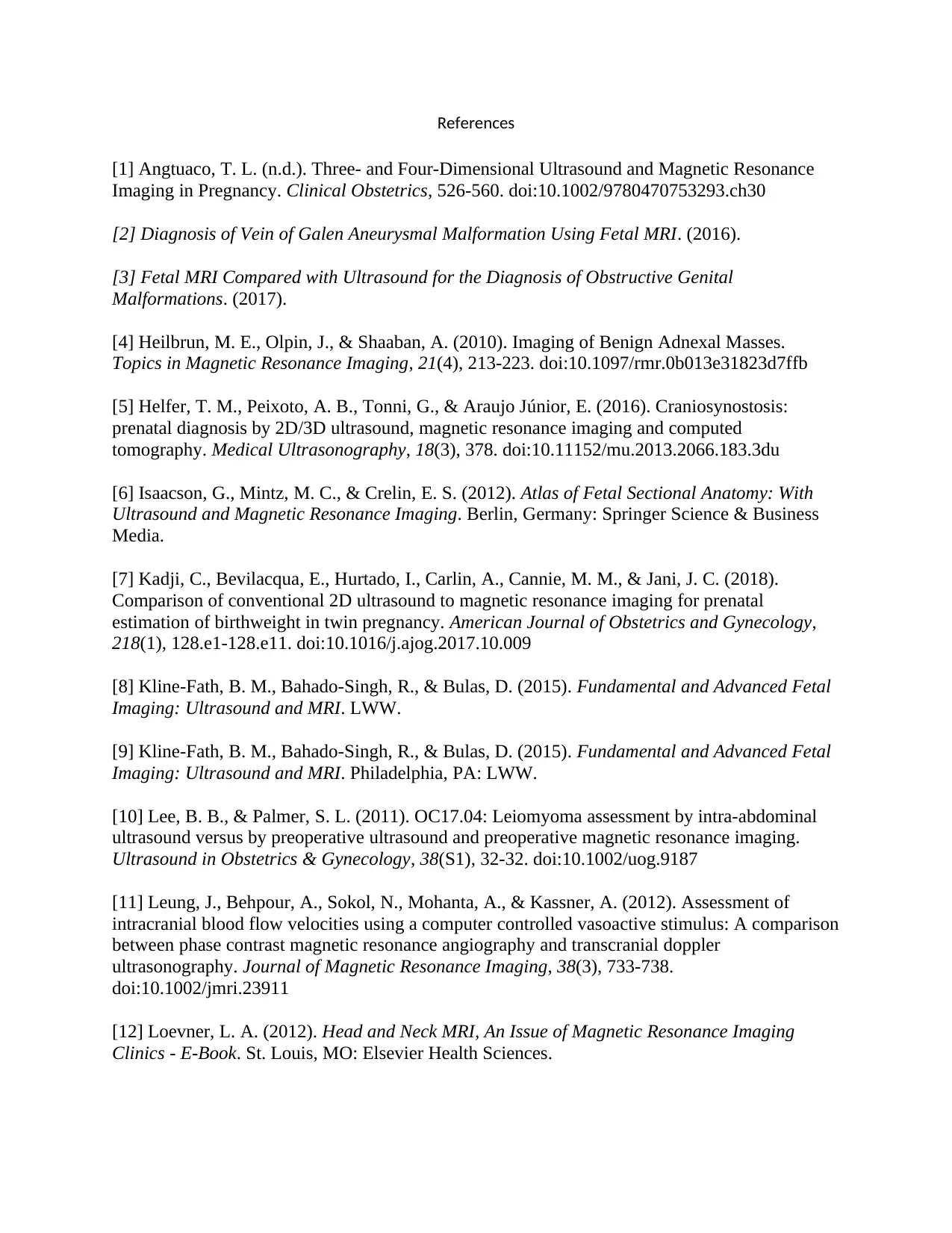
References
[1] Angtuaco, T. L. (n.d.). Three- and Four-Dimensional Ultrasound and Magnetic Resonance
Imaging in Pregnancy. Clinical Obstetrics, 526-560. doi:10.1002/9780470753293.ch30
[2] Diagnosis of Vein of Galen Aneurysmal Malformation Using Fetal MRI. (2016).
[3] Fetal MRI Compared with Ultrasound for the Diagnosis of Obstructive Genital
Malformations. (2017).
[4] Heilbrun, M. E., Olpin, J., & Shaaban, A. (2010). Imaging of Benign Adnexal Masses.
Topics in Magnetic Resonance Imaging, 21(4), 213-223. doi:10.1097/rmr.0b013e31823d7ffb
[5] Helfer, T. M., Peixoto, A. B., Tonni, G., & Araujo Júnior, E. (2016). Craniosynostosis:
prenatal diagnosis by 2D/3D ultrasound, magnetic resonance imaging and computed
tomography. Medical Ultrasonography, 18(3), 378. doi:10.11152/mu.2013.2066.183.3du
[6] Isaacson, G., Mintz, M. C., & Crelin, E. S. (2012). Atlas of Fetal Sectional Anatomy: With
Ultrasound and Magnetic Resonance Imaging. Berlin, Germany: Springer Science & Business
Media.
[7] Kadji, C., Bevilacqua, E., Hurtado, I., Carlin, A., Cannie, M. M., & Jani, J. C. (2018).
Comparison of conventional 2D ultrasound to magnetic resonance imaging for prenatal
estimation of birthweight in twin pregnancy. American Journal of Obstetrics and Gynecology,
218(1), 128.e1-128.e11. doi:10.1016/j.ajog.2017.10.009
[8] Kline-Fath, B. M., Bahado-Singh, R., & Bulas, D. (2015). Fundamental and Advanced Fetal
Imaging: Ultrasound and MRI. LWW.
[9] Kline-Fath, B. M., Bahado-Singh, R., & Bulas, D. (2015). Fundamental and Advanced Fetal
Imaging: Ultrasound and MRI. Philadelphia, PA: LWW.
[10] Lee, B. B., & Palmer, S. L. (2011). OC17.04: Leiomyoma assessment by intra-abdominal
ultrasound versus by preoperative ultrasound and preoperative magnetic resonance imaging.
Ultrasound in Obstetrics & Gynecology, 38(S1), 32-32. doi:10.1002/uog.9187
[11] Leung, J., Behpour, A., Sokol, N., Mohanta, A., & Kassner, A. (2012). Assessment of
intracranial blood flow velocities using a computer controlled vasoactive stimulus: A comparison
between phase contrast magnetic resonance angiography and transcranial doppler
ultrasonography. Journal of Magnetic Resonance Imaging, 38(3), 733-738.
doi:10.1002/jmri.23911
[12] Loevner, L. A. (2012). Head and Neck MRI, An Issue of Magnetic Resonance Imaging
Clinics - E-Book. St. Louis, MO: Elsevier Health Sciences.
[1] Angtuaco, T. L. (n.d.). Three- and Four-Dimensional Ultrasound and Magnetic Resonance
Imaging in Pregnancy. Clinical Obstetrics, 526-560. doi:10.1002/9780470753293.ch30
[2] Diagnosis of Vein of Galen Aneurysmal Malformation Using Fetal MRI. (2016).
[3] Fetal MRI Compared with Ultrasound for the Diagnosis of Obstructive Genital
Malformations. (2017).
[4] Heilbrun, M. E., Olpin, J., & Shaaban, A. (2010). Imaging of Benign Adnexal Masses.
Topics in Magnetic Resonance Imaging, 21(4), 213-223. doi:10.1097/rmr.0b013e31823d7ffb
[5] Helfer, T. M., Peixoto, A. B., Tonni, G., & Araujo Júnior, E. (2016). Craniosynostosis:
prenatal diagnosis by 2D/3D ultrasound, magnetic resonance imaging and computed
tomography. Medical Ultrasonography, 18(3), 378. doi:10.11152/mu.2013.2066.183.3du
[6] Isaacson, G., Mintz, M. C., & Crelin, E. S. (2012). Atlas of Fetal Sectional Anatomy: With
Ultrasound and Magnetic Resonance Imaging. Berlin, Germany: Springer Science & Business
Media.
[7] Kadji, C., Bevilacqua, E., Hurtado, I., Carlin, A., Cannie, M. M., & Jani, J. C. (2018).
Comparison of conventional 2D ultrasound to magnetic resonance imaging for prenatal
estimation of birthweight in twin pregnancy. American Journal of Obstetrics and Gynecology,
218(1), 128.e1-128.e11. doi:10.1016/j.ajog.2017.10.009
[8] Kline-Fath, B. M., Bahado-Singh, R., & Bulas, D. (2015). Fundamental and Advanced Fetal
Imaging: Ultrasound and MRI. LWW.
[9] Kline-Fath, B. M., Bahado-Singh, R., & Bulas, D. (2015). Fundamental and Advanced Fetal
Imaging: Ultrasound and MRI. Philadelphia, PA: LWW.
[10] Lee, B. B., & Palmer, S. L. (2011). OC17.04: Leiomyoma assessment by intra-abdominal
ultrasound versus by preoperative ultrasound and preoperative magnetic resonance imaging.
Ultrasound in Obstetrics & Gynecology, 38(S1), 32-32. doi:10.1002/uog.9187
[11] Leung, J., Behpour, A., Sokol, N., Mohanta, A., & Kassner, A. (2012). Assessment of
intracranial blood flow velocities using a computer controlled vasoactive stimulus: A comparison
between phase contrast magnetic resonance angiography and transcranial doppler
ultrasonography. Journal of Magnetic Resonance Imaging, 38(3), 733-738.
doi:10.1002/jmri.23911
[12] Loevner, L. A. (2012). Head and Neck MRI, An Issue of Magnetic Resonance Imaging
Clinics - E-Book. St. Louis, MO: Elsevier Health Sciences.

[13] Mahoney, M. C., & Newell, M. S. (2013). Screening MR Imaging Versus Screening
Ultrasound. Magnetic Resonance Imaging Clinics of North America, 21(3), 495-508.
doi:10.1016/j.mric.2013.04.001
[14] Masselli, G. (2015). MRI of Fetal and Maternal Diseases in Pregnancy. Basingstoke,
England: Springer.
[15] Matsubara, S., Takahashi, H., & Takei, Y. (2018). Magnetic resonance imaging for
diagnosis of placenta accreta spectrum disorders: still useful for real-world practice. American
Journal of Obstetrics and Gynecology, 219(3), 312-313. doi:10.1016/j.ajog.2018.04.058
[16] Ranger, B. (2016). Breast ultrasound tomography versus magnetic resonance imaging for
clinical display of anatomy and tumor rendering: Preliminary results. doi:10.31224/osf.io/j7nrf
[17] Rychik, J., & Tian, Z. (2011). Fetal Cardiovascular Imaging E-Book: Expert Consult
Premium. St. Louis, MO: Elsevier Health Sciences.
[18] Sar-el, M. T. (2016). Agreement Between Prenatal Ultrasound and Magnetic Resonance
Imaging Versus Post Mortem Autopsy in Festuses: A Retrospective Cross Sectional Study.
[19] Starke, R. M., & Dumont, A. S. (2014). Intraoperative Imaging and Assessment of Cerebral
Blood Flow in Cerebrovascular Surgery: Hybrid Operating Rooms, Intraoperative Angiography
and Magnetic Resonance Imaging, Doppler Ultrasound, Cerebral Blood Flow Probes,
Endoscopic Assistance, Indocyanine Green Videography, and Laser Speckle Contrast Imaging.
World Neurosurgery, 82(6), e693-e696. doi:10.1016/j.wneu.2013.10.045
[20] Vanel, D., & McNamara, M. T. (2012). MRI of the Body. Berlin, Germany: Springer
Science & Business Media.
Ultrasound. Magnetic Resonance Imaging Clinics of North America, 21(3), 495-508.
doi:10.1016/j.mric.2013.04.001
[14] Masselli, G. (2015). MRI of Fetal and Maternal Diseases in Pregnancy. Basingstoke,
England: Springer.
[15] Matsubara, S., Takahashi, H., & Takei, Y. (2018). Magnetic resonance imaging for
diagnosis of placenta accreta spectrum disorders: still useful for real-world practice. American
Journal of Obstetrics and Gynecology, 219(3), 312-313. doi:10.1016/j.ajog.2018.04.058
[16] Ranger, B. (2016). Breast ultrasound tomography versus magnetic resonance imaging for
clinical display of anatomy and tumor rendering: Preliminary results. doi:10.31224/osf.io/j7nrf
[17] Rychik, J., & Tian, Z. (2011). Fetal Cardiovascular Imaging E-Book: Expert Consult
Premium. St. Louis, MO: Elsevier Health Sciences.
[18] Sar-el, M. T. (2016). Agreement Between Prenatal Ultrasound and Magnetic Resonance
Imaging Versus Post Mortem Autopsy in Festuses: A Retrospective Cross Sectional Study.
[19] Starke, R. M., & Dumont, A. S. (2014). Intraoperative Imaging and Assessment of Cerebral
Blood Flow in Cerebrovascular Surgery: Hybrid Operating Rooms, Intraoperative Angiography
and Magnetic Resonance Imaging, Doppler Ultrasound, Cerebral Blood Flow Probes,
Endoscopic Assistance, Indocyanine Green Videography, and Laser Speckle Contrast Imaging.
World Neurosurgery, 82(6), e693-e696. doi:10.1016/j.wneu.2013.10.045
[20] Vanel, D., & McNamara, M. T. (2012). MRI of the Body. Berlin, Germany: Springer
Science & Business Media.
⊘ This is a preview!⊘
Do you want full access?
Subscribe today to unlock all pages.

Trusted by 1+ million students worldwide
1 out of 12
Your All-in-One AI-Powered Toolkit for Academic Success.
+13062052269
info@desklib.com
Available 24*7 on WhatsApp / Email
![[object Object]](/_next/static/media/star-bottom.7253800d.svg)
Unlock your academic potential
Copyright © 2020–2025 A2Z Services. All Rights Reserved. Developed and managed by ZUCOL.
